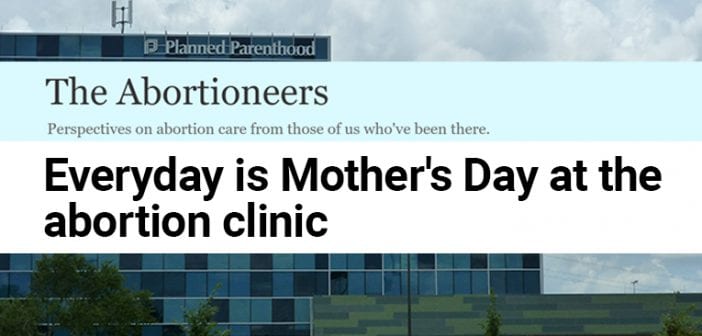On a radical anti-Life blog dubbed “The Abortioneers,” anonymous writers share their thoughts on working in the abortion industry. With posts carrying titles like “An Abortion Love Story,” the blog clearly features extreme anti-Life views. Nowhere is this so jarring as in a Mother’s Day post from several years ago. As we celebrate the mothers in our lives, this chilling reflection of an abortion worker offers a glimpse into the lies of the culture of death.
In a post entitled, “Everyday [sic] is Mother’s Day at the abortion clinic,” an anonymous author attempts to romanticize abortion in an ode to motherhood. Abortion, the violent death of a preborn child in his or her mother’s womb, cannot be romanticized without outright lies. What is beautiful about the death of a child? What is loving and sacrificial about an industry that preys on women and kills their babies for profit? According to this abortion worker, everything. In the lies of the culture of death, black becomes white, up becomes down, and “abortion is love.”
Interestingly, the author begins the short piece by acknowledging what many abortion activists carefully ignore. She writes:
Overwhelmingly, the inevitable commonality among women obtaining abortions is their fertility, particularly their pregnancy—the amount of occupied uteri hovering about an abortion clinic at any given time, the amount of mothers.
Many abortion activists refuse to acknowledge that women seeking elective abortions are already mothers. Anti-Life lobbyists huff that abortion should be regulated like “any other medical procedure,” refusing to acknowledge the obvious. Pregnancy is a unique, unparalleled event in which new Life forms in a mother’s womb. In waxing eloquent about her experience as an abortion worker, this author gets to the heart of the matter: women seeking abortions are mothers. Motherhood is a relationship of reciprocity. If there is a mother, there is also a child. Perversely, while tacitly acknowledging the living child in the womb, “The Abortioneers” attempt to glorify the abortion that violently ends that Life.
The author writes in generalities about the intense emotions surrounding abortion. She notes “the sickness,” “the fear,” “sadness,” “confusion.” Anyone who has known the pain of abortion knows these emotions well. Yet, the author also claims abortion brings inspiration, a sense of the future, wisdom, and sacrifice. How could ending the Life of a helpless and innocent child be a source of such lofty thoughts and feelings in the eyes of the abortion industry?
The answer comes in the devastating conclusion of the brief essay. The author muses:
Abortion is utmost motherhood—a woman transpiring her valued comfort zone to preserve the destiny of her offspring. Abortion is life and death. A code of honor. A sacred rite.
Abortion is love.
The culture of death, profiting from killing of the preborn, says that abortion is a mother’s ultimate gift to her children. Blind to the blood of the innocents, the abortion industry tries to sell the lie that killing children is a service to mothers. What could be further from the full joy of motherhood?

